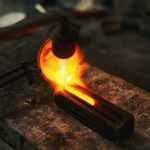 Embarking on a journey into the realm of metal heat treating is like delving into the alchemy of metallurgy. It involves a set of intricate processes that transform the physical properties of metal to enhance its strength, hardness, and durability. In this comprehensive guide, we will unravel the fundamentals of metal heat treating, from the foundational concept of annealing to the crucial step of quenching. Let’s dive into the essential processes that constitute the backbone of this fascinating metallurgical practice.
Embarking on a journey into the realm of metal heat treating is like delving into the alchemy of metallurgy. It involves a set of intricate processes that transform the physical properties of metal to enhance its strength, hardness, and durability. In this comprehensive guide, we will unravel the fundamentals of metal heat treating, from the foundational concept of annealing to the crucial step of quenching. Let’s dive into the essential processes that constitute the backbone of this fascinating metallurgical practice.
Understanding Annealing: A Gentle Introduction
At the heart of metal heat treating is the process of annealing, which serves as a gentle introduction to the transformative world of metallurgy. Annealing involves heating metal to a specific temperature and then allowing it to cool slowly. This controlled cooling relieves internal stresses, softens the metal, and refines its grain structure. Annealing is often the starting point for various heat treating processes, laying the groundwork for subsequent treatments that impart specific properties to the metal.
Normalizing: Refining Structure for Uniformity
Normalizing is a heat treating process designed to refine the structure of metal, making it more uniform and predictable. Unlike annealing, normalizing involves cooling the metal in still air. This controlled cooling process enhances the mechanical properties of the metal, reducing internal inconsistencies and improving its overall stability. Normalizing is particularly useful in preparing the metal for subsequent heat treatments, ensuring a more consistent and reliable outcome.
Quenching: The Crucial Step for Rapid Cooling
One of the defining moments in metal heat treating is the quenching process. After heating the metal to a specific temperature, it is rapidly cooled by immersion in a quenching medium such as water, oil, or air. Quenching locks in the desired properties obtained during the heating phase, creating a hardened structure. This step demands precision, as the rate of cooling directly influences the final characteristics of the metal. The careful orchestration of quenching is an art that skilled metallurgists master to achieve the desired balance between hardness and brittleness.
Tempering: Fine-Tuning for Optimal Performance
Following the intense transformation of quenching, the metal undergoes tempering—a crucial step that involves reheating it to a lower temperature. Tempering imparts additional strength and toughness to the metal while reducing its brittleness. The temperature and duration of tempering are critical factors, as they determine the final mechanical properties of the metal. This delicate balancing act allows metallurgists to fine-tune the material, ensuring it meets the specific requirements of its intended application.
Case Hardening: Strengthening the Surface
In some applications, surface hardness is of paramount importance. Case hardening is a metal heat treating technique that selectively hardens the outer layer of a metal component while maintaining a relatively softer core. This is achieved by introducing carbon or nitrogen-rich elements during the heating process. The result is a hardened surface that can withstand wear and abrasion, coupled with a more ductile core that prevents brittleness.
Mastering the Symphony of Metal Heat Treating
As we conclude our exploration into the fundamentals of metal heat treating, it becomes evident that this metallurgical symphony involves a series of carefully orchestrated processes. From the gentle introduction of annealing to the crucial steps of quenching, tempering, and case hardening, each stage contributes to the metamorphosis of metal, enhancing its properties for specific applications. Whether creating durable tools, robust machinery components, or intricate automotive parts, a mastery of these fundamental processes empowers metallurgists to unlock the full potential of metal, shaping it into forms that withstand the test of time and stress.
